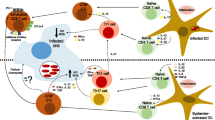Abstract
Cutaneous infection of most inbred mouse strains with the protozoan parasite, Leishmania major, leads to a localized lesion that is contained and resolved primarily by CD4+ Th1 cells (1,2). Th1 cells secrete the potent macrophage activator IFN-γ, thus stimulating effective killing of this parasite (1,3). A few inbred mouse strains, such as BALB/c and SWR, fail to control parasite replication. This failure results in progressive lesion development, spread to visceral organs and eventual death. Highly susceptible BALB/c mice have been shown to make a strong immune response, but one that is dominated by CD4+ Th2 cells (4), which inhibit macrophage activation by producing IL-4, IL-10 and IL-13 (5). This sharp delineation of Th1 and Th2 responses has made L. major infection a useful model for studying the control of functional differentiation in CD4+ T cells. The clear strain differences in the response to L. major also offer the opportunity to study the genetic factors that determine whether an animal can mount a protective or a pathogenic immune response to this infection.
Access this chapter
Tax calculation will be finalised at checkout
Purchases are for personal use only
Preview
Unable to display preview. Download preview PDF.
Similar content being viewed by others
References
Liew, F. Y. and C. A. O’Donnell. 1993 Immunology of leishmaniasis. Adv.Parasitol 32:161.
Reiner, S. L. and R. M. Locksley. 1995 The regulation of immunity to Leishmania major. Annu. Rev. Immunol. 13:151.
Murray, H. W. 1994 Interferon-gamma and host antimicrobial defense: current and future clinical applications. Am. J. Med. 97:459.
Heinzel, F. P., M. D. Sadick, B. J. Holaday, R. L. Coffman, and R. M. Locksley. 1989 Reciprocal expression of interferon gamma or IL4 during the resolution or progression of murine leishmaniasis. Evidence for expansion of distinct helper T cell subsets. J. Exp. Med. 169:59.
Mosmann, T. R. and R. L. Coffman. 1989 TH1 and TH2 cells: Different patterns of lymphokine secretion lead to different functional properties. Ann. Rev. Immunol. 7:145.
Roberts, M., B. A. Mock, and J. M. Blackwell. 1993 Map** of genes controlling Leishmania major infection in CXS recombinant mice. European Journal of Immunogenetics 20:349.
Mock, B., J. Blackwell, J. Hilgers, M. Potter, and C. Nacy. 1993 Genetic control of Leishmania major infection in congenic, recombinant inbred and F2 populations of mice. European Journal of Immunogenetics 20:335.
Krishnan, L., L. J. Guilbert, T. G. Wegmann, M. Belosevic, and T. R. Mosmann. 1996 T helper 1 response against Leishmania major in pregnant C57BL/6 mice increases implantation failure and fetal resorptions. Correlation with increased IFN-gamma and TNF and reduced IL-10 production by placental cells. J. Immunol. 156:653.
Spielman, R. S., R. E. McGinnis, and W. J. Ewens. 1993 Transmission test for linkage disequilibrium: the insulin gene region and insulin-dependent diabetes mellitus (IDDM). Am. J. Hum. Genet. 52:506.
Beebe, A. M., S. Mauze, N. J. Schork, and R. L. Coffman. 1997 Serial backcross map** of multiple loci associated with resistance to Leishmania major in mice. Immunity. 6:551.
Giannini, M. S. 1986 Sex-influenced response in the pathogenesis of cutaneous leishmaniasis in mice. Parasite.Immunol. 8:31.
Bartlett, M. S. and J. B. S. Haldane. 1935 The theory of inbreeding with forced heterozygosity. J. Genetics 31:327.
Roberts, L. J., T. M. Baldwin, J. M. Curtis, E. Handman, and S. J. Foote. 1997 Resistance to Leishmania major is linked to the H2 region on chromosome 17 and to chromosome 9. J. Exp. Med. 185:1705.
Gorham, J. D., M. L. Guler, R. G. Steen, A. J. Mackey, M. J. Daly, K. Frederick, W. F. Dietrich, and K. M. Murphy. 1996 Genetic map** of a murine locus controlling development of T helper 1/T helper 2 type responses. Proc.Natl.Acad.Sci.U.S.A. 93:12467.
Author information
Authors and Affiliations
Corresponding author
Editor information
Editors and Affiliations
Rights and permissions
Copyright information
© 1998 Springer Science+Business Media New York
About this chapter
Cite this chapter
Coffman, R.L., Beebe, A.M. (1998). Genetic Control of the T Cell Response to Leishmania Major Infection. In: Gupta, S., Sher, A., Ahmed, R. (eds) Mechanisms of Lymphocyte Activation and Immune Regulation VII. Advances in Experimental Medicine and Biology, vol 452. Springer, Boston, MA. https://doi.org/10.1007/978-1-4615-5355-7_8
Download citation
DOI: https://doi.org/10.1007/978-1-4615-5355-7_8
Publisher Name: Springer, Boston, MA
Print ISBN: 978-1-4613-7443-5
Online ISBN: 978-1-4615-5355-7
eBook Packages: Springer Book Archive




